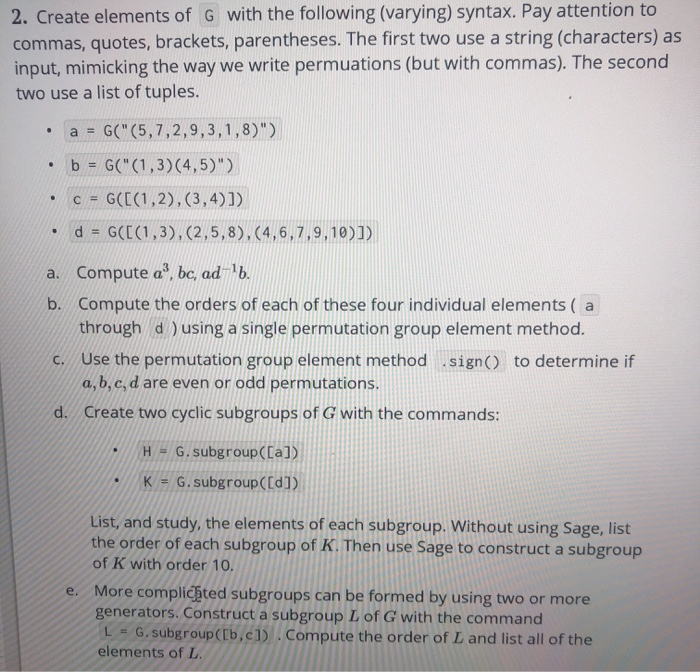using python

2. Create elements of G with the following (varying) syntax. Pay attention to commas, quotes, brackets, parentheses. The first two use a string (characters) as input, mimicking the way we write permuations (but with commas). The second two use a list of tuples. . a = G("(5,7,2,9,3,1,8)") . b = G("(1,3)(4,5)") c = G([(1,2),(3,4)]) d = G([(1,3), (2,5,8),(4,6,7,9,10)]) a. Compute a?, bc, ad-1b. b. Compute the orders of each of these four individual elements ( a through d using a single permutation group element method. C. Use the permutation group element method sign() to determine if a, b, c, d are even or odd permutations. d. Create two cyclic subgroups of G with the commands: H = G. subgroup([a]) K = G. subgroup([d]) List, and study, the elements of each subgroup. Without using Sage, list the order of each subgroup of K. Then use Sage to construct a subgroup of K with order 10. More complicated subgroups can be formed by using two or more generators. Construct a subgroup L of G with the command L = G. subgroup ([b,c1) Compute the order of L and list all of the elements of L. 2. Create elements of G with the following (varying) syntax. Pay attention to commas, quotes, brackets, parentheses. The first two use a string (characters) as input, mimicking the way we write permuations (but with commas). The second two use a list of tuples. . a = G("(5,7,2,9,3,1,8)") . b = G("(1,3)(4,5)") c = G([(1,2),(3,4)]) d = G([(1,3), (2,5,8),(4,6,7,9,10)]) a. Compute a?, bc, ad-1b. b. Compute the orders of each of these four individual elements ( a through d using a single permutation group element method. C. Use the permutation group element method sign() to determine if a, b, c, d are even or odd permutations. d. Create two cyclic subgroups of G with the commands: H = G. subgroup([a]) K = G. subgroup([d]) List, and study, the elements of each subgroup. Without using Sage, list the order of each subgroup of K. Then use Sage to construct a subgroup of K with order 10. More complicated subgroups can be formed by using two or more generators. Construct a subgroup L of G with the command L = G. subgroup ([b,c1) Compute the order of L and list all of the elements of L








